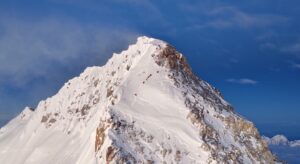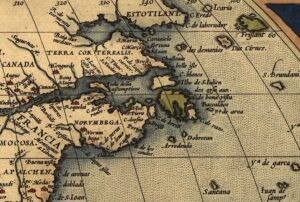A hundred years ago this spring, George Mallory and Andrew “Sandy” Irvine disappeared in the clouds around the summit ridge of Everest. They never reappeared.
Since then, the mystery about whether the climbers reached the summit before perishing has inspired hypotheses, rumors, and not a few conspiracy theories. Mallory’s body was discovered in 1999, but the remains of Irvine with a camera that could conceivably show summit pictures are a kind of Holy Grail for a certain stripe of armchair mountaineers, and others.
Searching for Irvine
This year’s centenary of that ill-fated 1924 Everest expedition will surely bring the tragic pair back into the spotlight. Before climbing, Mallory mentioned that if he succeeded, he’d leave a portrait of his wife on the summit. Mallory’s clothing did not contain such a portrait, but a small piece of cardboard could easily disappear on that windy summit over the years.

Mallory and Irvine items found on the upper slopes of Everest. Photo: astro-udec.cl
The key to the mystery has always been that Vest Pocket Kodak camera that the British pair carried. Since Mallory’s body had no camera, the device should be with Irvine. But where, oh where is Irvine’s body?
Five years ago, in 2019, just before the Chinese closed the North Side of Everest to foreigners, two expeditions scoured the upper slopes for Irvine’s remains, without success.
Thom Pollard took part in the first expedition, as a high-altitude cameraman. The Everest mystery came to obsess him, and he suggested to long-time friend and author Mark Synnott that they organize a second search.
The team was pretty sure of the exact location of the body, based on research by Tom Holzel, who had used documents and a high-res image of the area by Bradford Washburn. Pollard told Synnott that he knew the exact location of the body.

American researcher Tom Holzel and the high-res picture of Everest’s yellow band, where he believed Irvine’s body was. Frame of a video by Peter Holzel
‘He’s not there’
Upon returning, Synnott described the expedition in several articles, including this one for National Geographic :
Ten feet to my right was a small alcove hemmed by a rock wall a bit taller and steeper than the one I had just climbed down. The middle of the wall was striped with a vein of dark brown rock with a narrow crack in the middle. The GPS said I’d arrived. That’s when it hit me: The dark rock was the “crevice” we had seen with the drone. Apparently it was an optical illusion. The crack in the center was only nine inches wide. Far too narrow for a person to crawl inside. And it was empty. He’s not here.

Andrew “Sandy” Irvine. Photo: Wikipedia
The Chinese connection
When asked even before the expedition about how sure he was, Tom Holzel had said “It can’t not be there.” But then, where was Irvine’s body?
In a series of articles and then in his book The Third Pole, Synnot brought alleged new evidence that supported an old rumor, namely, that Chinese climbers found and retrieved the body in 1975. Check the conversation with Pollard about the contents of the book and the investigative work behind it here.
Early rumors
Modern “sightings” of Sandy Irvine’s body started when two members of the 1999 expedition that found Mallory’s body — leader Eric Simonson and main researcher Jochen Hemleb — visited Beijing two years later. They spoke with the leader of the first Chinese expedition to Everest’s North side, Xu Jing. Xu retreated from exhaustion near the summit, but he mentioned he had seen a dead climber near the First Step.

Thom Pollard (left) interviews Mark Synnott about his book ‘The Third Pole.’ Frame from Pollard’s ‘Everest Mystery’ series on YouTube
Years earlier, in 1979, the leader of a Japanese expedition spoke to Wang Hong-Bao, a member of the 1975 Everest expedition. Wang said he had seen a dead climber with old European clothes at 8,100m. Unfortunately, Wang died in an avalanche the day after that conversation. The story never really reached the western climbing community. However, Synnott states the remains were either moved or taken down the mountain at the time. He adds two sources, both of them third- or fourth-hand.
Source 1
Retired U.S. Marine Wayne Wilcox reported that he was in Beijing for the Olympics when his wife had a conversation with a British diplomat. The diplomat told her he had previously talked with Pan Duo (Phanghog, according to Liz Hawley’s account on The Himalayan Database), the only female member of the 1975 Everest North Side expedition. She became the first Chinese woman and the second woman overall to summit Everest.
Apparently, Pan Duo told the diplomat, who told Wilcox’s wife, who told Wilcox, who told Synnot and Thom Pollard (watch the video interview here) that the climbers had found a body at about 8,200m. She mentioned there was a camera with the body but when the film was developed in Beijing, the film had no pictures. When she later spoke to journalists (according to Wilcox), she changed her account and said that she recalled no camera.

A Kodak camera like the one Mallory and Irvine brought up Everest. Frame from a video by Peter Holzel
Source 2
The leader of the 2019 expedition, Jamie McGuinness, had heard similar rumors over the years. McGuinness, a New Zealander, has been guiding in the Himalaya for decades through his company Project Himalaya. He has been to the North Side of Everest 10 times, summiting on 5 occasions.
McGuinness first heard the rumor years earlier from a Sherpa, who later refused to confirm the story. On a later expedition in 2010, a China Tibet Mountaineering Association (CMTA) official at Everest Base Camp admitted to McGuinness that the body had been moved many years before.

Jamie McGuinness on one of his Everest summits, in 2008. Photo: Project Himalaya
It is not clear, however, whether they removed the remains from the mountain or just threw it somewhere out of the path.
In 2015, McGuinness visited what was then a private museum near Lhasa. Here, he saw a display of a boot and some climbing artifacts, purportedly from the 1920s. “I was surprised, wondering how these artifacts ended up here.
“In the end, I got the impression that these Tibetans had assumed that everybody knew that the body had been taken away from the mountain,” McGuinness told Thom Pollard in an interview last week. “I also had the feeling that some people might decide to speak up, as long as their names remained anonymous.”
Hesitation
Pollard answered during the interview: “That is probably why, when we were preparing for the 2019 research expedition with National Geographic, there was some hesitation in Jamie’s voice, as if he believed we were not going to be successful, which is the opposite of what I thought at the time.”
Check the interview and McGuinness’ testimony here, on Pollard’s YouTube Channel, Everest Mystery.
On a final note, Pollard explained to ExplorersWeb why they have been investigating such rumors so intently.
“When Synnott and I started the expedition, we invested all the money we had; National Geographic joined in later. If we had had this information, we would have never gone looking for Irvine, neither would National Geographic have funded the project.”
As for returning to the mountain, Pollard is sure he will not. “But if someone wanted to look around, I would perhaps search on the foot of the mountain, in case the body was really thrown down.”
The coming season
How accurate the rumor of finding/moving Irvine is or is not remains to be seen. Currently, the Chinese connection to this classic mystery has created the expected debate on social media. Pollard’s video interviews have thousands of views, and podcasters and bloggers who doubt the rumors have attracted similarly large audiences.
Synnott’s book is available in paperback and is recommended by several outdoor magazines, and the 2019 expedition footage led to National Geographic‘s documentary Lost on Everest and the short film The Ghosts Above. In the latter, drone pilot Renan Ozturk offers his point of view.
Meanwhile, the North Side of Everest has finally reopened to foreign outfitters. Several have already confirmed their expeditions and will fly to Tibet in a few weeks. With this new flurry of publicity, no doubt some members will keep their eyes open.
Still, with each passing year, the likelihood of solving the mystery fades. Climbers will continue to head up and down the mountain in the footprints of the two British pioneers, without knowing how far they actually reached. And perhaps this is the way it should be.

Last photo of Mallory and Irvine, shot by Noel Odell at the North Col. The climbers launched their final summit push two days later.






